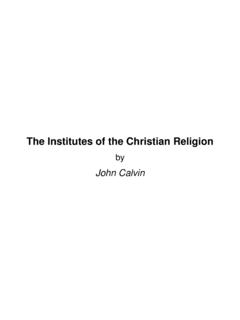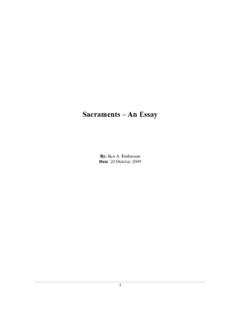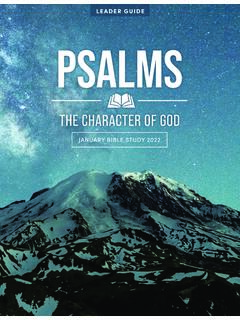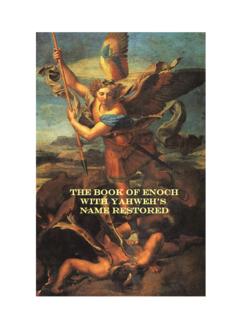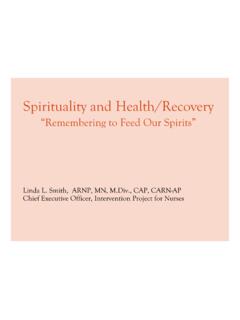Transcription of The Oneness of God
1 David K. BernardPentecostal TheologyThe Oneness of GodVOLUME 1 The Oneness of Godby David K. BernardCopyright 1983 by David K. BernardPrinting history: 1983, 1984, 1985, 1986, 1987, 1989, 1990, 1991, 1992,1993, 1994, 1995, 1997 Cover Design by Paul PovolniAll Scripture quotations in this book are from the King James Version of theBible unless otherwise rights reserved. No portion of this publication may be reproduced, storedin an electronic system, or transmitted in any form or by any means, electron-ic, mechanical, photocopy, recording, or otherwise, without the prior permis-sion of Word Aflame Press. Brief quotations may be used in literary in the United States of AmericaPrinted byLibrary of Congress Cataloging-in-Publication DataBernard, David K.
2 , 1956-The Oneness of God.(Series in Pentecostal theology ; v. 1)Bibliography: God. 2. Trinity Controversial literature. 3. God Oneness doctrine (Pentecostalism)1. Title. 11. Series: Bernard, David K., 1956 Series in Pentecostal theology ; v. 1986231 .04486-19051 ISBN 0-912315-12-1To ConnieFOREWORDU nderstanding is aimed for in these pages. Jesusknew the common Aramaic language. Sometimes Hespoke Hebrew, a language only the scholars used atthat time. Jesus could converse in Greek, the tongueof the educated man. To whomever Jesus spoke, Hisaim was to be understood. The greatest teacher of allages spoke in terms all could and simplicity at the same time.
3 Whata paradox! The author of this book has accomplishedthe seemingly impossible. He has transmitted intellec-tual depth while preserving simplicity. It is a theolog-ical miracle. Often the really profound is the mostsimple, and the simple the most truly profound. Thetreatment of the Oneness of God in this book isdesigned to be simple; but the truths are profound,scholarly, priceless, and essential to the people of Godand a lost book must meet at least two main criteria tobe a best seller. It must be written interestingly andmust fill a need. The author accomplishes know the author and his burden is to under-stand more of the book.
4 I hope you can meet himand know him as I do. David Bernard is a humanexample of Christian principles. May these pagesbecome a classic among us and a guide to the search-ing world as they discover the one, true, and livingGod. I now commend the author and book to you andall L. CraftJackson, Mississippi 4 TABLE OF CONTENTSFOREWORD.. 4 AUTHOR S PREFACE.. MONOTHEISM.. 13 Monotheism defined. The Old Testament teachesthere is but one God. The New Testament teachesthere is but one God. NATURE OF GOD.. 23 God is a Spirit. God is invisible. God is omnipresent(everywhere present). Does God have a body?
5 Godis omniscient (all knowing). God is omnipotent(all powerful). God is eternal. God is immutable(unchanging). God has individuality, personality,and rationality. God s moral attributes. angel of the LORD. Melchisedec. The fourthman in the fire. Are there New Testament theo-phanies? NAMES AND TITLES OF GOD.. 42 The significance of a name. Names or titles ofGod in the Old Testament. Compound names ofJehovah. The progressive revelation of the name IS GOD.. 55 The Old Testament testifies that Jesus is God. TheNew Testament proclaims that Jesus is God. Godwas manifest in the flesh as Jesus.
6 The was God from the beginning of His human 5 life. The mystery of godliness. Jesus is the is Jehovah. The Jews understood that Jesusclaimed to be God. Jesus is the One on the Revelation of Jesus Christ. Jesus has all theattributes and prerogatives of God. SON OF GOD.. 85 The meaning of Jesus and Christ. The dual natureof Christ. Historical doctrines of Christ. Jesus hada complete, but sinless, human nature. Could Jesussin? The Son in biblical terminology. Son of of man. The Word. Begotten Son or eternalSon? The beginning of the Son. The ending of theSonship. The purposes for the Son.
7 The Son andcreation. The first begotten. Hebrews 1 , SON, AND HOLY GHOST.. 125 The Father. The Son. The Holy Ghost. The Fatheris the Holy Ghost. The Deity of Jesus Christ isthe Father. The Deity of Jesus Christ is the HolyGhost. Father, Son, and Holy Ghost. Matthew 28 John 5:7. Is God limited to three manifestations? TESTAMENT EXPLANATIONS.. 146 Elohim. Genesis 1:26. Other plural pronouns. Themeaning of one (Hebrew, echad). to Abraham. The angel of the Son and other references to the Messiah. TheWord of God. The wisdom of God. Holy, holy, of Godor LORD. The Spirit of the LORD.
8 6 The LORDGod and His Spirit. The Ancient of Daysand the Son of man. Fellow of Jehovah. TESTAMENT EXPLANATIONS:THE GOSPELS.. 170 Four important aids to understanding. The bap-tism of Christ. The voice from heaven. The prayersof Christ. My God, my God, why hast thou for-saken me? Communication of knowledge betweenpersons in the Godhead? The preexistence of Son sent from the Father. Love between per-sons in the Godhead? Other distinctions betweenFather and Son. The with passages. Two witness-es. Plural usage. Conversations between personsin the Godhead? Another Comforter. Are Jesus andthe Father one in purpose only?
9 TESTAMENT EXPLANATIONS:ACTS TO REVELATION.. 200 The right hand of God. Greetings in the Apostolic Benediction. Other threefold refer-ences in the Epistles and Revelation. The fulnessof God. Philippians 2:6-8. Revelation 1:1. Theseven Spirits of God. The Lamb in Revelation did God allow confusing verses of Scripture? BELIEVERS INCHURCH HISTORY.. 236 The post-apostolic age. Oneness , the dominantbelief in the second and third centuries. Modalisticmonarchianism. Oneness believers from the fourth 7 century to the present. Modalistic Monarchianism: Oneness in Early Church History. : DEFINITION ANDHISTORICAL DEVELOPMENT.
10 255 Definition of the doctrine of the trinity. Problemswith tritheism. Problems with terminology. Historical development oftrinitarianism. Pagan origins. Post-apostolic develop-ments. Tertullian the father of Christian trinitari-anism. Other early trinitarians. The Council ofNicea. After Nicea. The Athanasian Creed. TheApostles Creed. : AN EVALUATION.. 286 Nonbiblical terminology. Person and persons. Mystery. The deity of Jesus Evaluation of trinitarianism. Thedoctrine of the trinity contrasted with does the average church member believe? .. 301 BIBLIOGRAPHY.. 307 GLOSSARY.. 312 SCRIPTURE INDEX.

